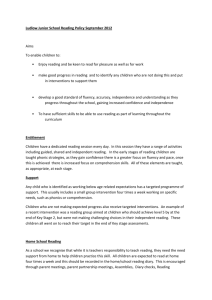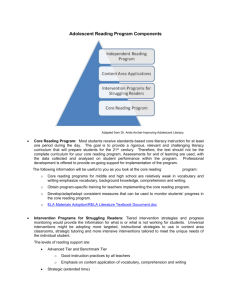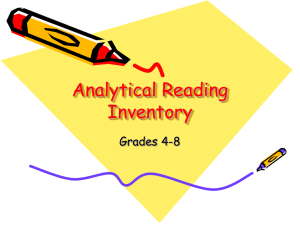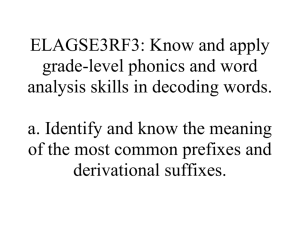Secondary Literacy Planning
advertisement
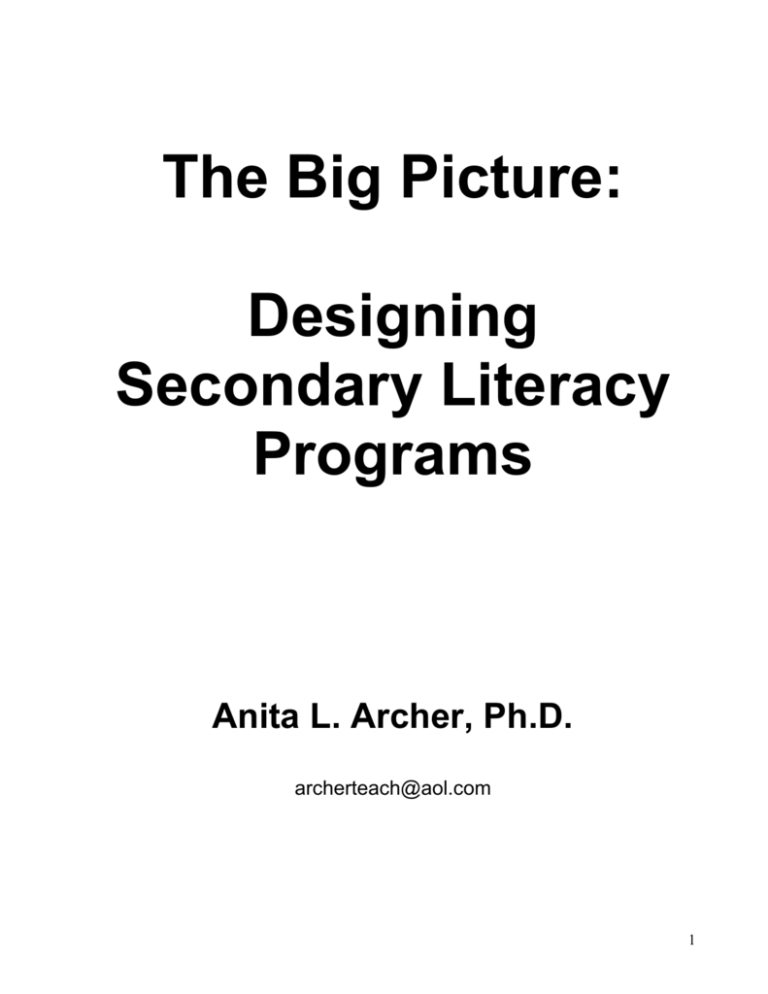
The Big Picture: Designing Secondary Literacy Programs Anita L. Archer, Ph.D. archerteach@aol.com 1 WHY SHOULD WE FOCUS ON LITERACY? More than eight million students in grades 4-12 are struggling readers (U.S. DOE, 2003). Every school day, more than three thousand students drop out of high school (Alliance for Excellent Education, 2003). Only 70% of high school students graduate on time with a regular diploma. Fewer than 60% of African-American and Latino Students graduate on time with a regular diploma (Green, 2002). Over 75% of students who drop out of school ascribe major significance to the difficulties experienced in learning to read (Lyon, 2001) Among the prison population, 70% demonstrate literacy at the two lowest levels of reading proficiency (NIFL, 1998). Between 1996 and 2006, the average literacy required for all American occupations is projected to rise by 14% (Barton, 2000). Between 1973 and 1998, in skilled blue-collar, clerical, and related professions, the percentage of workers who were high school dropouts fell by two-thirds, while the percentage of workers with some college or a college degree doubled (Carnevale, 2001). 90 to 95% of poor readers can experience improved reading skills (to average levels) through well-designed reading programs offered by highly trained teachers (Lyon, 1998). 2 Pyramid of Strength: A School-wide Reading Program 7 Components • Oral Language • Phonemic awareness • Decoding • Fluency • Vocabulary/background knowledge • Comprehension • Writing Programs Assessment • Core Reading Programs • Screening for placement • Intensive Interventions • Strategic Interventions • Content-Area Applications • Progress monitoring • Outcome measures • (Collect, analyze, adjust) • Independent Reading Effective Instruction Time Grouping Design Delivery Professional Development Knowledge of Research Knowledge of Programs Planning and Adjusting Program and Instruction Empowerment Leaders Teachers Parents Students Climate Common Vision Focus on Achievement Commitment Positive 3 Building Blocks of Reading Instruction Phonemic Awareness - - Understanding that words contain sounds. Critical Skills – Blending of sounds into words and segmenting words into sounds Important focus for beginning readers at any grade level Fluency - Related to reading comprehension Also related to amount read, work completion, and test performance Accuracy plus rate plus expression A product of practice * Independent Reading * Passage Reading in Class * Repeated Reading Decoding - - Vocabulary and Background Knowledge - - Comprehension Strategies - - Related to decoding, fluency, and vocabulary Need to increase thinking about and focus on critical information Need cognitive strategies for summarizing, questioning, organizing, and monitoring what is read Need narrative and expository comprehension strategies Necessary for comprehension Accounts for much of the difference between struggling and proficient readers Letter-sound associations Decoding of short words Prefixes and Suffixes Decoding of long words Strengthened by parallel spelling instruction Necessary for comprehension Vocabulary expanded through * Independent Reading * Explicit Vocabulary Instruction * Word Learning Strategies Practice activities * Engaging * Multiple exposures * Deep processing * Relate to prior knowledge Teach or activate background knowledge Writing Strategies - Struggling readers are usually struggling writers Need to be able to write coherent paragraphs Need to be able to write coherent essays 4 Secondary Reading Programs Intense Interventions – Reading Level 0 – 2.5 Reading Components: Phonemic Awareness Decoding (Short words, irregular words) Fluency (Word and passage) Vocabulary Comprehension Intense Interventions – Reading Level 2.5 – 5.0 Reading Components: Decoding (Long Words) Fluency Vocabulary Comprehension Writing Intense Interventions – Reading Level 5.0 to 7.0 Reading Components: Decoding (Long Words) Fluency Vocabulary Comprehension Writing Core Reading Program Reading Components: Decoding Fluency Vocabulary Comprehension Writing Content Area Reading Program Reading Components: Decoding Fluency Vocabulary Comprehension Writing Independent Reading Program Application of all components 5 Before, During, and After Passage Reading Before Passage Reading Interventions During Passage Reading Interventions After Passage Reading Interventions Introduce the pronunciation of difficult words. Tell them the pronunciation of irregular words. Guide them in using their strategy on regular words. Teach the meaning of critical vocabulary. Activate or teach critical background knowledge. Preview the passage. Guide students in reading the passage. Ask students questions to check their understanding and to model active reading. Engage students in using strategies: Expository: verbal rehearsal, note-taking, mapping Narrative: story grammar Have students complete a graphic organizer Engage students in a discussion on the material. Guide students in answering o multiple choice questions on the article’s content o short answer questions Provide engaging vocabulary practice including activities such as: Yes/No Why Completion Activities Quick Words Guide students in planning, writing, and editing Summaries Extended Responses Essays (Based on REWARDS PLUS published by Sopris West) 6 Secondary Reading Programs – A Planning Tool Anita L. Archer, Ph.D. Archerteach@aol.com 7 Common Vision • In order to participate in all aspects of life, students must read at the highest level possible. • With very few exceptions, students can learn to read at grade level. • A major mission of secondary schools is to insure the highest reading attainment by all students. Operating Principles • The reading program should emphasize the major components of reading: oral language, phonemic awareness, decoding, fluency, vocabulary, comprehension, and writing. • Students at different reading levels need different programs that emphasize appropriate components of reading instruction. • An adequate amount of engaged, instructional time must be allocated in order to optimize student growth. • All students should receive at least one period of reading instruction per day. • Struggling readers will need more instructional time in order to close the achievement gap. This can be done through additional periods of reading instruction, after school programs, and intense summer school programs. • To maximize the growth of all students, flexible performance grouping should be used. • Placement decisions will be based on assessment data including: performance on state tests, a fluency measure, and a normreferenced reading test. • Performance data will be consistently collected and analyzed. • The reading program will be adjusted based on student performance. • A total reading program would include the following components: - a core reading program for the majority of the students - intervention programs for struggling readers - content area reading applications - independent reading program 8 Core Reading Program Big Ideas • The majority of students should receive at least one period a day of reading instruction in a core reading program in 6th – 9th grades. • The core reading program should emphasize the following components: vocabulary and background knowledge, comprehension, and writing. Tasks and Subtasks Task A: Select a research-based core reading program. • Develop/adopt/adapt an evaluation tool to examine core reading programs that reflects critical components of reading, effective instructional practices, and ease of teacher implementation. • Using this evaluation tool, review available research-based core reading programs. • Select the program that best matches the established criterion, the population to be served, and the fiscal resources of the school. • Supplement the program if any components are not covered adequately (e.g., an additional fluency program). Task B: Obtain appropriate professional development to support implementation of the program. • Obtain program-specific training for teachers implementing the core reading program. • Provide additional training for support personal, reading coaches, and administrators. Task C: Develop a plan for monitoring students’ progress within the core reading program. • Develop/adopt/adapt screening measures to determine placement in appropriate program. This should include use of state assessments, a fluency measure, and a norm-referenced reading test. • Develop/adopt/adapt consistent measures that can be used to monitor students’ progress in the core reading program. Task D: Implement the program. 9 • Order materials necessary for program implementation. • Organize materials for easy access and distribution. • Using data from screening, assign students to appropriate classes. • Schedule students into appropriate reading programs. • TEACH effectively using instructional strategies that engage all students. Task E: Collect and analyze data on student performance. Adjust students’ placement and the program based on student data. • Collect data on students’ performance within the program. • Analyze the data to determine if students need to be moved to another group, need additional input, would profit from an intensive intervention OR if the program needs modification. Task E: Provide on-going support for implementation of the program. • Design procedures for on-going staff development (e.g., short reviews at staff meetings). • Provide coaching to teachers needing help in implementing the program. • Design and implement a plan to increase accountability and program fidelity (e.g., principal/coach walk-throughs, analysis of student data). 10 Intensive Reading Programs _________________ Big Ideas • Struggling readers need to be placed in researchvalidated or research-based programs with proven effectiveness in accelerating student gains. • Struggling readers will need extended instructional time to accelerate gains. This might include more than one period of instruction per day, after school programs, or intense summer school interventions. • Struggling readers benefit from systematic, explicit instruction with ample practice opportunities and cumulative review. • The intensive reading programs should emphasize the components of reading needed by the students including: oral language, phonemic awareness, decoding, fluency, vocabulary, comprehension and writing. Tasks and Subtasks _______________________________________________ Task A: Select a research-based intensive reading program. • Develop/adopt/adapt evaluation tools that reflect critical components of reading, effective instructional practices, and ease of teacher implementation. • Using these evaluation tools, review available research-validated and research-based intervention programs that are age appropriate for secondary students. Examples Intensive Intervention (1-3.0) Corrective Reading (SRA) Language! (Sopris West) Wilson Reading Program (Wilson) Interventions (3.0-5.0) Higher levels of: Corrective Reading or REACH Language! Wilson Reading Program System 180 (with decoding component added) REWARDS (Sopris West) REWARDS PLUS (Sopris West) Additional fluency practice Six Minute Solution (Sopris West) Read Naturally (Read Naturally) • Select programs or packages of programs that best match the established criterion, the population to be served, and the fiscal resources of the school. Task B: Obtain appropriate professional development to support implementation of programs. • Obtain program-specific training for teachers implementing the intervention programs. • Provide additional training for support personal, reading coaches, and administrators. 11 Task C: Develop a plan for monitoring students’ progress within the intervention reading program. • Develop/adopt/adapt screening measures to determine placement in the appropriate program. This should include use of state assessments, a fluency measure, and a norm-referenced reading test. • Identify program specific placement materials that can be used to place students in the appropriate level of the selected program. • Develop/adopt/adapt consistent measures that can be used to monitor students’ progress in intervention programs. • Develop/adapt/adapt fluency measures that relate to the selected programs that can be administered at least once every four weeks to monitor progress. Task D: Implement the program. • Order materials necessary for program implementation. • Organize materials for easy access and distribution. • Using data from screening, assign students to appropriate classes. • Schedule students into appropriate reading programs. • TEACH effectively using instructional strategies that engage all students. Task E: Collect and analyze data on student performance. Adjust students’ placement and the program based on student data. • Collect data on students’ performance within the program. • Analyze the data to determine if students need to be moved to another group, need additional input, OR if the program needs modification. • Review the progress of students receiving intensive programs at least every four to six weeks to allow ease of movement from program to program. Task E: Provide on-going support for implementation 12 of the program. • Design procedures for on-going staff development (e.g., short reviews at staff meetings). • Provide coaching to teachers needing help in implementing the program. • Design and implement a plan to increase accountability and program fidelity (e.g., principal/coach walk-throughs, analysis of student data). 13 Content Area Reading Tasks and Subtasks Big Ideas Task A: Select content-area textbooks that are “friendly” and promote good content area reading practices. • It is critical that students learn to read informative text with ease. • Students would benefit from teachers using excellent instructional practices before, during, and after passage reading that would promote reading comprehension. • Students would also benefit from instruction on powerful learning strategies that they can utilize in a number of settings. • A special emphasis should be placed on improving students’ vocabulary and background knowledge before passage reading. • Develop/adopt/adapt evaluation tools that reflect desired content, text structure, text elements (e.g., clear headings and subheadings), instructional procedures (e.g., preteaching of vocabulary and necessary background knowledge), and reading strategies (e.g., writing summaries, completing graphic organizers). • Using these evaluation tools, review available content area textbooks. • Select content area textbooks that best match the established criterion, the population to be served, and the fiscal resources of the school. Task B: Select instructional practices that can be implemented in a variety of classes to enhance reading comprehension. • Select research-validated instructional practices that can be implemented before, during, and after passage reading to increase student comprehension. • Select research-validated learning strategies that can be introduced to students and applied in a variety of content area classes. Examples Teaching Reading in the Content Areas: If not me then who? (McRel) www.mcrel.org Creating Independence Through Student-Owned Strategies (Project CRISS) www.projectcriss.com Advanced Skills for School Success www.curriculumassociates.com 14 • Students would also benefit from instruction on powerful learning strategies that they can utilize in a number of settings. • A special emphasis should be placed on improving students’ vocabulary and background knowledge before passage reading Task C: Obtain appropriate professional development to introduce research-validated teacher and student strategies to enhance reading comprehension in content area textbooks. • Provide professional development to all teachers on research-validated practices to be used before, during, and after reading. • Provide professional development on selected learning strategies. • Provide specific professional development on vocabulary instruction. Task D: Implement content area instructional procedures and student learning strategies. • Implement instructional procedures and learning strategies in all content area classes. • Provide on-going staff development to encourage the use of selected strategies. • Design and implement a plan to increase accountability and fidelity in use of selected strategies (e.g., principal/coach walkthroughs). 15 Independent Reading Program Big Ideas: • Struggling readers do very little reading outside of school. Tasks and Subtasks Task A: Determine a school-wide policy concerning the amount of independent reading that will be required. • Determine the amount that will be required of students (e.g., number of books per week; amount of time per week). • An intentional program is Task B: Develop a plan for encouraging independent necessary to increase the reading. amount of independent reading done by all students. • Develop a plan for encouraging independent reading that includes some of the following elements: • When the amount of - self-selection of books reading increases, students - procedures to select books at the independent level gain in decoding, - ways to share book recommendations vocabulary, background - opportunities to talk abut books knowledge, fluency, and - a school climate that promotes reading comprehension skills. - accountability for independent reading - incorporation of independent reading into language/arts • Vocabulary is particularly reading grade enhanced by reading a variety of material. Task D: Provide easy access to appropriate independent reading materials. • Provide easy access to independent reading materials through some/all of the following methods: - a library with extended hours - in-class book mobiles (carts of library books) - book exchanges - book sales - Task E: Collect and analyze data on students’ independent reading. 16




